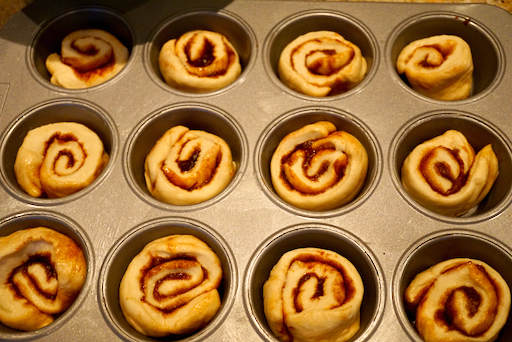While my wife was browsing the Washington Post, she found several small pie (tassie) recipes for the holidays. One was called "Buttermilk chess tassie". We are not sure of the origin of "chess" but it is reportedly a classic southern pie. "Tassie" is not a word we were familiar with but it means a small pie or tart and reportedly originated from the Scottish word "tass" meaning a small goblet. In any case we will call this "Buttermilk Mini Pie". This is perfect for us since it uses buttermilk (of which we have an abundant supply since my wife started making it) and it is small. A perfect single sweet bite as a dessert.
The below was C&P (cut and paste) from WP recipe.
Ingredients:
For the crust
4 tablespoons (2 ounces/60 grams) unsalted butter, softened, but still cool to the touch
1 1/2 ounces (40 grams) cream cheese, softened, but still cool to the touch
1/2 cup plus 1 tablespoon (70 grams) all-purpose flour
For the filling
1/3 cup (65 grams) granulated sugar
3 tablespoons buttermilk
1 large egg, cold
1/2 teaspoon vanilla extract
1/8 teaspoon fine sea salt or table salt
2 tablespoons (30 grams) unsalted butter
Recipe doubled:
For the crust
8 tablespoons (4 ounces/120 grams) unsalted butter, softened, but still cool to the touch
3 ounces (80 grams) cream cheese, softened, but still cool to the touch
1 cup plus 2 tablespoon (140 grams) all-purpose flour
For the filling
2/3 cup (130 grams) granulated sugar
6 tablespoons buttermilk
2 large eggs, cold
1 teaspoon vanilla extract
1/4 teaspoon fine sea salt or table salt
4 tablespoons (60 grams) unsalted butter
Directions:
To make the crust: In the bowl of a stand mixer fitted with the paddle attachment — or, if using a hand mixer, in a large bowl — beat together the butter and cream cheese until smooth, about 2 minutes. Stop the mixer and add the flour. On low speed, mix until no streaks remain and the dough starts to come together, about 1 minute. Scrape any stray dough from the sides of the bowl, gather into a ball and flatten into a smooth rectangle or disc. Cover tightly and refrigerate for 1 hour.
Cut the cold dough into 12 equal pieces, (I did this by dividing the total weight of the dough by 12 to get the gram weight of each piece. That way they would at least be somewhat equal). Using your fingers, evenly press each piece into the bottom and up the sides of 12 mini muffin cups, making sure there are no holes. (This part was a bit tricky because it was hard to get the dough evenly distributed. Rolling the dough into a round does not work well. I found the best way was to make a small ball out of the dough, put it in the cup then using my thumb push down on the center of the ball forcing a depression in the center and the displaced dough up the sides of the cup.) Also, I wasn’t sure how easy it would be to get the little pies out of the cups once cooked so I put half of them in mini-muffin papers and the rest just in the greased cup. Turns out there is enough butter in the recipe that the papers were not necessary. Refrigerate uncovered, while making the filling.
Position a rack in the middle of the oven and preheat to 350 degrees.
Make the filling: In a medium bowl or 1-pint glass measuring cup, whisk together the sugar, buttermilk, egg, vanilla and salt until just combined. In a small skillet over high heat, melt the butter until it foams, 1 to 2 minutes. Continue cooking, stirring occasionally, until it starts to turn brown and smell nutty. Use some of the butter to temper the egg mixture. Then add the rest of the butter and stir until blended.
Retrieve the muffin pan from the refrigerator, and add 1 heaping tablespoon of filling into each dough cup, filling it almost to the top. (I used the smallest ice cream scoop).
Bake for 15 to 20 minutes, or until the crust is golden brown and the filling is set.
Transfer the pan to a wire rack and let cool completely before removing the tassies.
In any case, this was sweet smooth with some tang from the buttermilk. The browned butter gives it a rich nuttiness. I am not a dessert eater but I had no trouble “choking” this down.





















